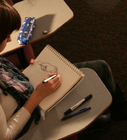How to Draw a "Tactical Folder" Blade
Chances are if you carry a Tactical Folding blade or have studied Knife Combat, you may have spent hours training the various techniques that are necessary to defend one's self in the event that you may ever have to use that blade. But how much time have you spent training and developing the simple movement of drawing that blade? This simple movement of drawing can become complex and even difficult when faced with a true "Life and Death" self protection situation. That's why this article is dedicated to drawing your tactical folder.
|
This article has been tagged as a stub. That means it's off to a good start, but still has plenty of room to grow before it reaches its full potential. Can you help it flourish? If you think the article offers complete and accurate instructions, feel free to remove this tag! |
EditSteps
-
1Access and body position is important! Although there are as many techniques and preferences as there are people in the world it is most important to be able to access and draw from any position at any angle. That means that technique and one particular stance is not as important as principle and fundamentals. In general your stance or position for a better use of the word should allow you immediate access to your blade, wherever you choose to holster or carry it. There should be no obstructions in between your cutting hand and the blade itself.
-
2The blade should be carried in a position in which minimum exertion and movement is needed in order to rapidly employ the blade. Most prefer to carry their Tactical folders clipped to the inside of their strong side pocket. This is because in most cases the strong side is also the cutting (weapon hand).
-
3All movements should be streamlined and tight, yet fluid. When drawing large loose movements should be avoided. The cover hand (Non cutting hand) immediately moves into "Guard" position; and the cutting hand stays tight to the body using the most direct path to the blade. These tight streamlined, economical movements and the covering hand make it difficult for any assailant to prevent you from drawing your blade or take it from you. It is also speedy.
-
4It's a 3 part movement. The first part involves the movement of your cover hand into the guard position and simultaneously moving the cutting hand to the blade. *Note* This can be done standing, seated or on the ground. The second part of the movement requires that you actually draw the blade from the storage/ holster position, asserting firm control of the weapon. This movement is best executed by grasping the blade and clip and retracting it from the pocket in a sharp upward motion using the movement from the elbow and shoulder on the Draw side. The third part of the movement is a sharp yet smooth movement and transition from the place (Pocket) where you store your blade to the "Guard" position. That is unless your first movement is a direct attack on the enemy or assailant.
We could really use your help!
trapping large animals?

shoulder holsters?

sobriety?

dogs?

EditTips
- Slow is Smooth and Smooth is Fast! It is important that when training you use slow decisive detailed movement in drawing and perform these movements repetitively. The more that you execute the draw in a slow manner, the more ways you learn to execute the movement economically and more quickly.
- Keep all movements tight and fluid
- Stay relaxed - the more tense that you are the more difficult it becomes to execute a fine movement like drawing especially in a real "Self Protection" scenario where your heart rate may be up to 180 beats per minute.
- Practice, Practice, Practice!!! This is a fine movement and that means that in a real scenario it will be more difficult to execute, because in life and death scenarios the adrenaline flows and the heart rate accelerates to abnormally high levels. This is because of "Fight or Flight" where the blood flow to the capillaries of the small muscles is reduced and the blood flow to the large muscles of the body is increased. The more you do this the more of a "Second nature response" you will create.
- Become familiar with the weapon you carry! Train and practice manipulating and moving the weapon in a variety of different movements and positions.
EditWarnings
- There is only one way to practice this technique and that is the actual act of drawing a live blade. This is potentially dangerous and requires serious attention to detail. It is not recommended to participate in this type of training unless you are and adult and have an immediate (First Responder) or first aid kit near by.
- Knives are weapons and should be respected and treated as such at all times. Please ensure that while conducting "Live Blade" training the immediate area is clear of all bystanders, and that any bystanders are in a safe direction away from the live blade.
- Tactical Drawing is the only recommended "Live Blade Training"; and it is strongly suggested that you never attempt Knife versus knife or counter knife techniques with a live blade, serious injury or death could follow.
EditThings You'll Need
- Tactical Folding Blade (The one that you carry)
- First Aid Kit / First Responder near and ready









About this wikiHow